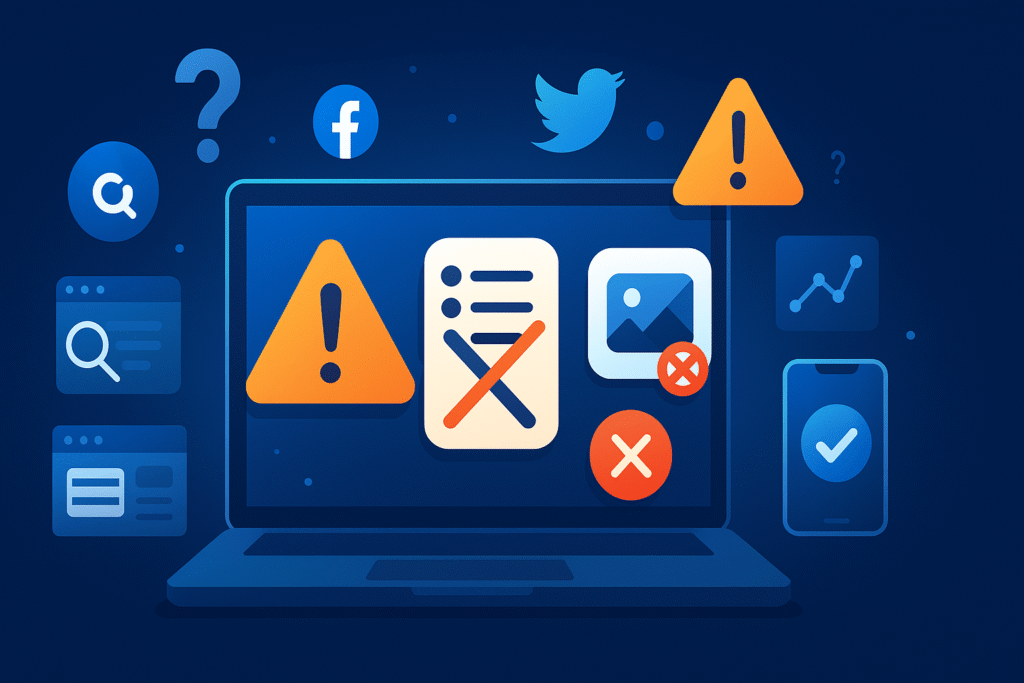If you’re running a small business, you’ve already figured out that having an online presence isn’t optional anymore – it’s essential. But what happens when you’re investing time and money into digital marketing, and the results just aren’t there? When are competitors attracting customers while your website remains invisible? When your Instagram has followers but zero sales?
The problem isn’t that digital marketing doesn’t work. The problem is that digital marketing mistakes for small businesses can cost you more than you think – not just financially, but in missed opportunities that could transform your business.
Over the years, working with small and medium-sized businesses, we’ve seen the same mistakes repeated over and over. The good news? They’re all fixable. In this post, you’ll learn what these mistakes are, why they happen, and – most importantly – how to correct them.
If you want your business to finally get the results it deserves online, keep reading.
Mistake #1: No Clear Digital Strategy
Why This Kills Your Marketing Before It Even Starts
Imagine starting a road trip without a map, GPS, or destination. You just drive and hope you’ll end up somewhere useful. Sounds ridiculous, right? Yet most small businesses approach digital marketing exactly this way.
They create an Instagram profile “because everyone has one.” They launch Google Ads campaigns “because they heard it works.” They built a website “because someone told them they needed one.”
The problem? No plan. No goal. No strategy.
What Happens When You Don’t Have a Strategy
Without a clear digital strategy, your marketing becomes a collection of random activities that drain resources but deliver no results. You post on social media without understanding who your audience is. You pay for ads without tracking conversions. You change your approach every week because “this isn’t working.”
The result? Frustration, wasted time, and the belief that digital marketing “isn’t for you.”
How to Fix It

Start with the basics. Before you invest another dollar in marketing, answer these questions:
Who is your target audience? Not “everyone who needs my product,” but a specific group of people with specific needs, problems, and behaviors.
Example: “Women aged 30-45 in urban areas, working professionals with children, looking for quick and healthy meal options for their families who don’t have time for lengthy meal preparation.”
What do you want to achieve? More sales? More inquiries? Greater brand awareness? Be specific – “I want 20 new clients per month” instead of “I want more customers.”
Example: “15 new clients per month ordering our meal delivery service, with an average order value of $50.”
Where is your audience online? If your customers aren’t on TikTok, don’t waste time there. Focus on channels where they’re active.
Example: “Instagram (recipes and nutrition tips), Facebook groups for busy parents, Google search (keywords like ‘healthy meal delivery [city name]’).”
How do you measure success? Which metrics matter for your business – website visitors, conversion rate, cost per client?
Example: “Number of completed contact forms on the website, number of direct messages on Instagram, conversion rate from inquiry to order, average order value.”
A digital strategy doesn’t have to be a complicated 50-page document. It can be a simple one-page plan – but it must exist.
Mistake #2: A Website That Doesn’t Work for You (Or No Website at All)
Your Website Is Your Most Important Salesperson – But Only If It Does Its Job
Let’s be honest. How many times have you opened a local business website and thought, “How does anyone buy anything here?” Slow loading. Outdated design. No clear information. No way to contact the owner. Or worst of all – the site doesn’t even work on mobile.
Here’s a shocking statistic: over 60% of internet traffic comes from mobile devices. If your website isn’t mobile-friendly, you’re losing more than half of your potential customers.
But the problem isn’t just technical details. Many small businesses have websites that look nice but don’t convert visitors into customers.
Most Common Website Mistakes
No clear call to action. A visitor lands on your site and… now what? They don’t know what to do. There’s no “Contact Us” button, no phone number in a visible place, no simple inquiry form.
It’s slow as molasses. If your site takes longer than 3 seconds to load, most people will leave. Google also penalizes slow sites in search results.
Missing basic information. Where are you located? How can they contact you? What exactly do you offer? How much does it cost? This information should be available within a few clicks.
Not optimized for search. If you haven’t invested in basic SEO, your website is invisible on Google. And if you’re not on Google, for most people, you don’t exist.
How to Fix It

Your website must be fast, clear, and action-focused. Here’s what you can do right now:
Check your site speed using free tools like Google PageSpeed Insights. If your score is below 50, you have a problem that’s costing you money.
Put a clear call to action on every page. “Schedule a Free Consultation,” “Call Us Now,” “Request a Quote” – whatever the next logical step is for your customer.
Test your site on your phone. Open it as if you were a customer. Is it easy to navigate? Are the buttons big enough? Can you read the text without zooming?
Add basic SEO elements – page titles with keywords, meta descriptions, optimized images. This isn’t rocket science, but it makes a huge difference.
And most importantly, your website must work for you 24/7. While you sleep, your site should be attracting, informing, and converting visitors into customers.
Mistake #3: Ignoring SEO or Misunderstanding How It Works
“SEO Is Expensive, Slow, and Complicated” – The Biggest Myth Small Businesses Believe
When we tell clients they need SEO optimization, we most often hear: “That’s for big companies” or “I don’t have the budget for that.” The truth is different – digital marketing mistakes for small businesses most often start right here, with complete neglect of SEO.
SEO isn’t a luxury. It’s the foundation of online visibility.
Think about it this way: when you need a plumber, electrician, or restaurant for a celebration, what do you do? You open Google and type “plumber [your city]” or “birthday party restaurant [your city].” If you’re not on the first page of results, you won’t get the call.
Why Small Businesses Get SEO Wrong
Myth #1: “SEO is too complicated for me.” True, there are advanced SEO techniques, but anyone can apply the basics. Proper page naming, using local keywords, optimizing site speed – these don’t require an IT degree.
Myth #2: “SEO takes a year to show results.” Incorrect. Local SEO can deliver first results in 2-3 months. If you optimize your site for “hair salon [your neighborhood]” and add a Google My Business profile, you can appear in local results within weeks.
Myth #3: “Just stuff the site with keywords.” This is an outdated technique that does more harm than good. Google today rewards quality, useful content – not randomly scattered keywords.
What SEO Actually Means for Your Business
SEO isn’t magic. It’s a process that helps Google (and your customers) find you more easily. When someone searches for what you offer, you want your site to appear among the first results.
For small local businesses, the focus should be on local SEO. That means:
- Optimize your Google My Business profile. This is free and incredibly powerful. Add accurate information, photos, business hours, and reviews. When someone searches for your service in your city, you’ll appear on the map.
- Use local keywords. Instead of generic “accounting services,” use “accounting services for small businesses [your city].” More specific = better.
- Ask for reviews from satisfied clients. Google loves sites with positive reviews. They build trust and improve rankings.
- Create useful content. A blog post that answers your customers’ common questions isn’t just helpful – it positions you as an expert and attracts organic traffic.

SEO isn’t a cost. It’s an investment that works for you long-term. While paid ads stop working the moment you stop paying, good SEO continues to attract customers for months and years.
Mistake #4: Social Media Without Strategy and Consistency
Posting Content Isn’t the Same as Social Media Marketing
You have an Instagram profile. You post a product photo when you remember. Sometimes a week goes by, sometimes a month. You have followers, but nobody comments. Nobody buys. And you think: “Social media doesn’t work for my business.”
The problem isn’t social media. The problem is your approach.
Most small businesses use social media like a digital billboard – they just post ads for their products and wait for someone to buy. But social media doesn’t work that way. It’s a place for building relationships, not just selling.
Most Common Social Media Mistakes
- Inconsistency. You post three posts in one week, then nothing for a month. Social media algorithms reward regularity. If you’re not active, your content won’t be shown.
- Only sales content. Every post is “Buy this,” “Sale,” “Discount.” People don’t follow brands to watch ads – they follow them for inspiration, education, entertainment, or value.
- Ignoring engagement. Someone leaves a comment or sends a message – and you respond three days later or never. That’s like a customer walking into your store, asking a question, and you ignoring them.
- Being everywhere instead of being good somewhere. Instagram, Facebook, TikTok, LinkedIn, Twitter… You don’t need to be on every platform. It’s better to be active and quality on one or two networks than poor on five.
How to Create a Strategy That Works
First, choose the right platform for your business. If you sell visual products (clothing, jewelry, food, design), Instagram is a natural choice. If you’re targeting an older audience or local customers, Facebook is still king. If you’re a B2B business, LinkedIn is where you need to be.
Second, create content that delivers value. The 80/20 rule is a good starting point: 80% of content should educate, entertain, or inspire, and only 20% should directly sell.
If you’re a hair salon, show hair transformations, share hair care tips, and introduce your team. If you sell coffee, teach people how to make the perfect espresso at home, tell the story of where the beans come from, and show the roasting process.
Third, be consistent. It’s better to post two quality posts per week regularly than five posts one week and nothing for the next three. Create a simple content plan and stick to it.
Fourth, communicate with your audience. Respond to comments. React to messages quickly. Ask questions in posts. Social media is a two-way street – the more you communicate, the more the algorithm rewards you.
And most importantly – track what works. Which posts get the most engagement? When is your audience most active? Which topics generate reactions? Use that information to improve your strategy.
Mistake #5: Not Measuring Results and Making Decisions “By Feel”
If You Don’t Measure, You Can’t Improve
Here’s a scenario we’ve seen countless times: a business owner invests money in Instagram ads for a month. Someone asks: “How many clients did you get?” Answer: “Well… It’s hard to say exactly, but I think it was a bit better.”
That’s not a strategy. That’s throwing money away and hoping for the best.
Digital marketing has one huge advantage over traditional marketing – everything can be measured. How many people visited the site? Where did they come from? How much time did they spend on the page? How many filled out the contact form? What did it cost per client?
Without this data, you’re making decisions in the dark.
Why Small Businesses Don’t Measure Results
Usually for three reasons:
- “I don’t know how.” Google Analytics, Facebook Insights, Instagram statistics – all this sounds complicated. But you can learn the basics in an hour, and that knowledge is worth more than any paid ad.
- “I don’t have time.” We understand – you’re running a business, not sitting at a computer all day. But 30 minutes per week reviewing statistics can save you thousands of dollars annually.
- “It’s enough for me to see that traffic is growing.” Maybe traffic is growing, but is profit growing? Maybe you’re attracting the wrong audience that looks but doesn’t buy. Without measuring, you don’t know what actually works.
Which Metrics Matter for Your Business

You don’t have to track everything – focus on what directly impacts your revenue.
For your website: Number of visitors is a nice metric, but more important is conversion rate – how many visitors become customers or clients. If you have 1,000 visitors and 2 inquiries, you have a problem. If you have 100 visitors and 10 inquiries, you’re doing something very right.
For social media: Number of followers is a vanity metric. More important is engagement – how many people react, comment, and share your content. And most importantly, how many of them move from social media to your website or contact you directly.
For ads: Don’t just look at how much you spent. Track cost per client (CPL – Cost Per Lead). If you spent $500 and got 5 clients, your CPL is $100. Is that acceptable for your business? It depends on the average customer value.
For SEO: Track keyword positions and organic traffic. Is your site moving toward the top of Google results? Are you getting more visitors without paying for ads?
How to Start Measuring
Start simple. Set up Google Analytics on your site (it’s free). Activate Facebook and Instagram statistics (you already have access if you have a business profile). Create a simple spreadsheet where you’ll record basic numbers once a week.
Set clear goals. Not “I want more customers,” but “I want 15 new clients per month with costs up to $1,000.” When you have a concrete goal, you can measure whether you’re achieving it.
And most importantly – use data for decisions. If you see that Instagram ads bring clients at $75 each, and Facebook ads at $150 each, where will you invest next month? If you see that blog posts about a certain topic attract the most visitors, what will you write more about?
Data isn’t just numbers. It’s a map that shows you where you’re spending money wisely, and where you’re wasting it.
Your Digital Marketing Doesn’t Have to Be Perfect – But It Must Be Strategic
If you recognized your business in any of these mistakes, you’re not alone. Most small businesses make the same mistakes – not because they don’t want to succeed, but because digital marketing often seems complicated and inaccessible.
But here’s the good news: digital marketing mistakes for small businesses aren’t a death sentence. They’re an opportunity for growth.
You don’t need a multinational company’s budget. You don’t need to be a technical expert. What you need is an approach based on strategy, consistency, and measuring results.
Start with one mistake. If you don’t have a clear strategy, sit down and answer those four key questions. If your website isn’t working properly, fix it. If you’re not measuring results, start today with basic metrics.
Every small change brings results. And when those small changes start adding up, your digital marketing stops being a cost – and becomes an investment that brings real customers and revenue.
3 Key Takeaways You Can Apply Right Now:
1. Define your target audience and goals before you invest another dollar in marketing. Without a clear strategy, every effort is random. Answer the questions: Who are your customers? What do you want to achieve? How do you measure success?
2. Optimize your website for speed, mobile devices, and clear calls to action. Your website is your most important salesperson – it must work 24/7. Check it on your phone, speed it up, and add clear buttons that lead to purchase or contact.
3. Start measuring key metrics and make decisions based on data, not feelings. Set up Google Analytics, track conversion rate, cost per client, and social media engagement. What gets measured can be improved.



